Which Personal Protective Equipment (PPE) should I use?
If you are exposed to chemicals, there is a risk of damage to your health. Protect yourself. Check your pesticide label for advice on what to wear when mixing pesticides, cleaning empty pesticide packs, spraying pesticides and cleaning spraying equipment.
Note that the label states the least PPE that should be worn. Make sure that you also check and comply with local laws about which PPE to use.
Protect your eyes
add
remove
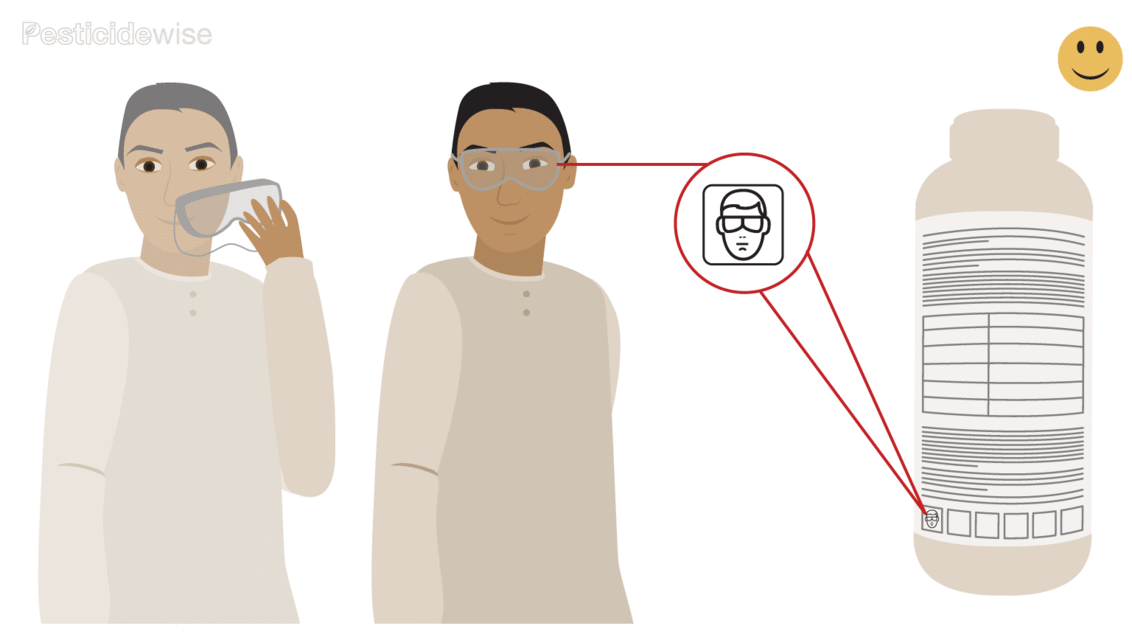
Wear goggles to protect your eyes from splashes, spray drops and dust. The use of goggles is often advised when:
- measuring and loading a product that is a risk to eyes
- spraying upwards or in confined spaces.
To wear your goggles
- Make sure that your hands (or gloved hands) are clean before putting your goggles on.
- Check that the seals are in proper contact with the face. If you wear eye glasses, consider safety glasses with lenses prescribed for you
- Each person should have and use their own set of goggles.
- Only use these goggles when using pesticides. Do not use the same pair of goggles for other purposes.
Hints and tips for choosing goggles
- Polycarbonate lenses are often used for goggles. These lenses are light, do not affect your vision and are resistant to most pesticides.
- Consider UV protection, tinting, anti-fog coating and scratch resistant lenses.
- Check that you can alter the straps on the goggles to seal the goggles comfortably to the face.
- Make sure that there is good side vision.
- Check that the goggles do not mist easily to reduce your vision. Indirect vents or no vents at all can reduce the problem but make sure that they do not let in drops, dusts or splashes.
Must: Goggles must be stored safely, away from light and dusts, preferably in a clean plastic bag.
Never: Never remove goggles to rub or clean your eyes without first being 100% sure that your hands are clean and so is the water you will use to wash your eyes.
Face shields are also used to protect eyes. Different types of goggles can be seen on this UK site.
Protect your face and mouth
add
remove
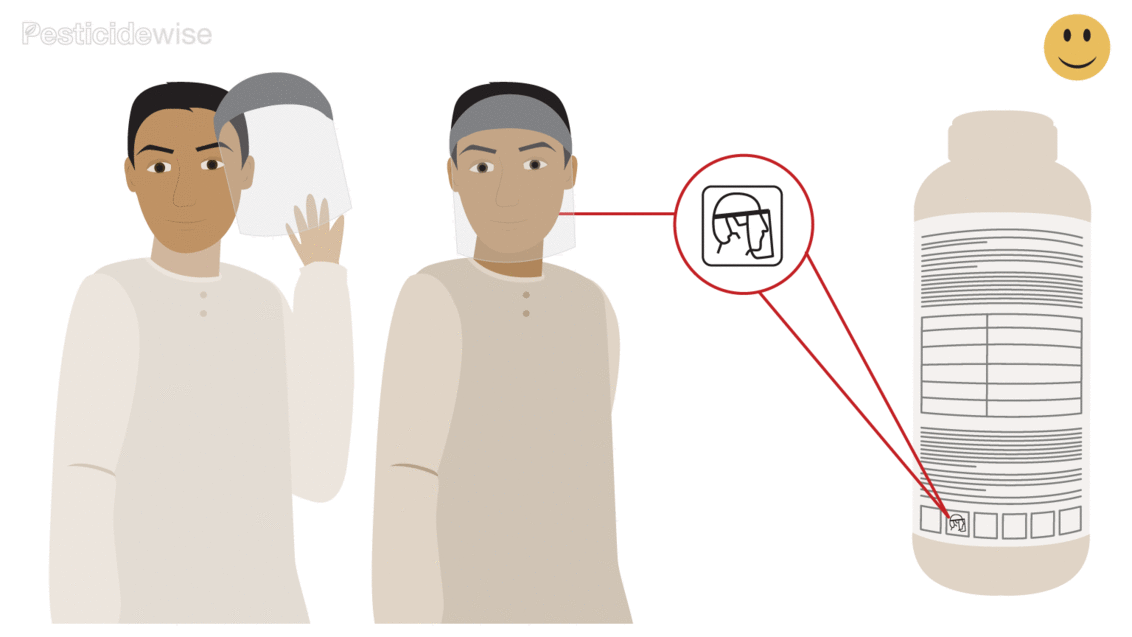
Wear a face shield to protect your face and mouth from splashes and larger drops of pesticides. Wear a face shield and goggles when mixing pesticides. Face shields will not protect you from vapours, fumes or mists; use a respirator to protect your lungs. Use goggles where you need better protection for your eyes. Some pesticide labels allow the use of dust masks.
To wear your face shield
- Fit your face shield with clean hands or gloves.
- Make sure that your face shield is clean, is in good condition and is ready for use.
- Where you are using a coverall, pull the coverall hood up before placing the shield over your hood and head.
- Adjust the securing straps so that the face shield fits your face and is secure.
- Check the fit for comfort. If you cannot adjust it, try using another type or size of face shield.
Hints and tips for choosing face shields
- Face shields made from polycarbonate or cellulose acetate are often scratch and chemical resistant.
- Check how well you can see through the shield.
- Check that you can adjust the face shield so that you will have good vision in front of you and to the sides.
Must: Keep your face shield safe and clean when not in use. Wash your gloves before you adjust or remove your face shield.
Never: Never forget that face shields will not protect operators from dangerous fumes, mists or dusts.
Protect your lungs
add
remove
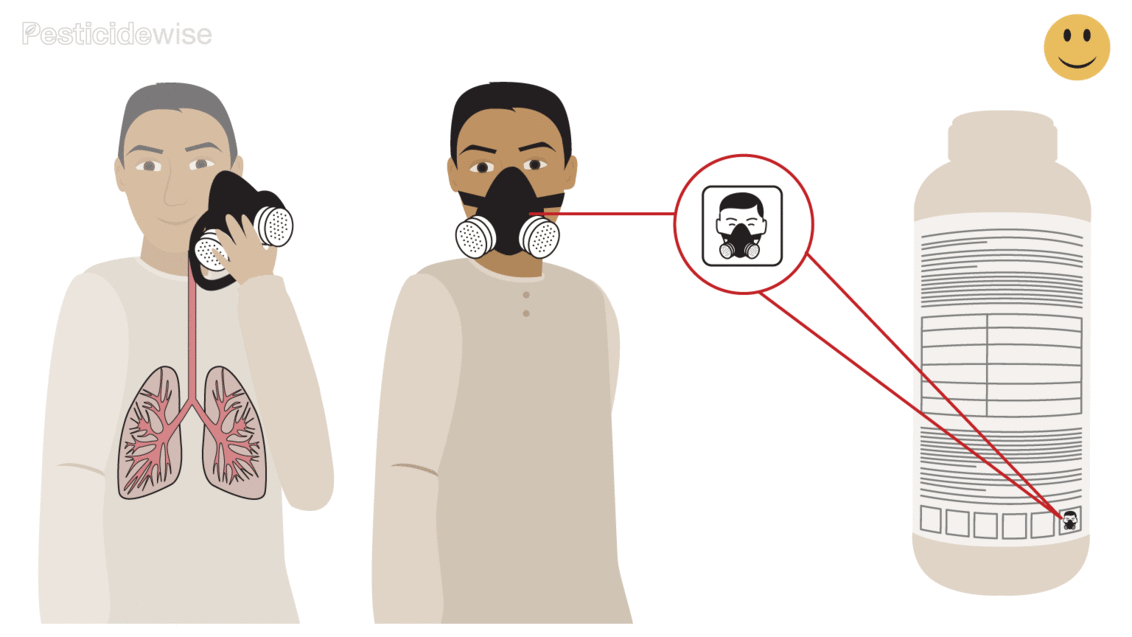
Protect your lungs with a respirator. Sprays are drops of liquid that move through the air. They can quickly evaporate to form very small particles that you can easily breathe into your lungs. The risk of inhaling pesticide spray is greater when spraying small and very small drops, upwards or laterally, in a confined space or with the wind blowing toward you. Take care when using hollow cone nozzles at high pressures which can produce small and very small drops.
For most conditions, respiratory protection should not be needed. However, when airborne exposure guidelines and/or comfort levels might be exceeded, use an approved air-purifying respirator. Respirators are designed to filter out small drops of pesticide before they can reach and damage the lungs.
Use a respirator to protect your lungs and nasal passages from:
- "Very Toxic" and "Toxic" pesticides
- vapors
- small drops or dust particles carried in the air.
To wear a respirator
- Check that the respirator is clean and in perfect condition.
- Check that all the straps are fitted and secure.
- Do a "fit test" to check that the respirator is the right size for you, and that the seal between the respirator and your skin is good.
- Make sure that face hair or eyewear does not spoil the seal.
Hints and tips for choosing respirators
Some types of respirator rely on the user breathing air through the cartridge or filter. Other types have clean air pumped to the respirator. This UK site shows many different types. Check your pesticide label and seek expert advice on which is the right respirator for your use.
Must: Replace filters, canisters, cartridges, and so on, whenever there is damage, breathing resistance, odour (smell), taste, irritation, or soiling. Also replace them when directed by the pesticide label or the respirator's instructions (whichever is most often).
When advised by the pesticide label to use a respirator, stop working if you smell pesticide, if breathing becomes difficult or if the skin on your face is irritated. Replace the cartridge or filter before you continue. If the pesticide label tells you to use a respirator, make sure that you have the knowledge and skills needed to use the pesticide.
Never: Never assume that the respirator you are to use is in perfect condition. Check it yourself. Never use a dust mask to do the work of a respirator.
Protect your hands
add
remove
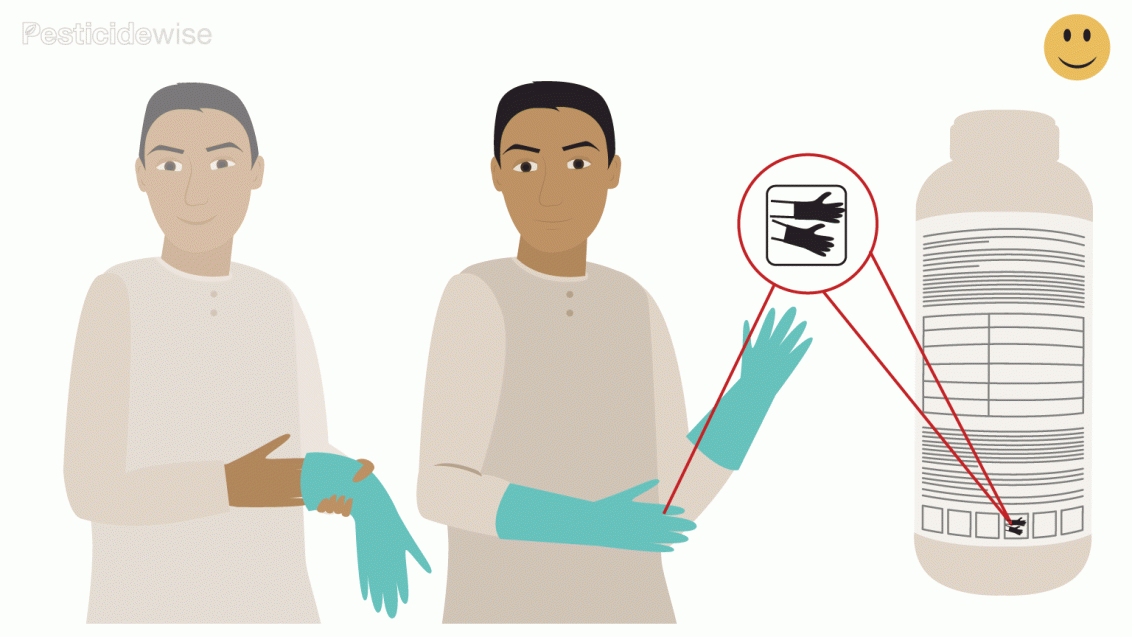
Hands and wrists are the part of your body most likely to come into contact with pesticides most often. You use your hands to open pesticide packs, measure undiluted product and use sprayers that may leak or drip. Hands are 5% of the surface of the body surface area but account for 60 - 80% of contact with pesticides.
Wear gloves to protect your hands and wrists when:
- mixing pesticide
- spraying pesticide
- cleaning your equipment.
To wear gloves
Wash your hands before putting your gloves on and clean your gloves before taking them off.
Hints and tips when choosing gloves
There are many types of chemical resistant materials that are used to make gloves: barrier laminate; butyl rubber; nitrile rubber; neoprene rubber; natural rubber; polyethylene; polyvinyl chloride (PVC) and Viton. These offer different levels of protection. You will need to choose gloves that will protect you from the pesticide that you are using. Some gloves will last for a longer or shorter time depending on:
- the type of material that is used to make them
- the type of pesticide that you are using
- whether the pesticide product is in granule, powder or liquid form or is a spray mix
- the type of solvent (if) used to make the pesticide product
- how often and for how long the gloves come into contact with a pesticide
Barrier laminate gloves are highly protective for many solvents that have been approved for use in pesticide formulations. Nitrile gloves are highly protective for many but not all formulations. Waterproof gloves are only protective for dry and water-based formulations.
Check your pesticide label to see which type of glove you need for the pesticide that you are using. Remember that elbow length gloves are more protective.
- Check the size for your comfort.
- Check that the glove allows adequate hand and finger movement.
- Check that the material will protect you during normal use for a reasonable period of time.
View some examples of gloves used with chemicals on this UK site.
Must: Always wear unlined gloves. Rinse gloves clean immediately if they come into contact with undiluted pesticide.
Never: Never wear canvas, leather, cotton or fabric gloves unless specified on the pesticide label.
Protect your legs and feet
add
remove
Wear coveralls or trousers and rubber boots to protect your legs and feet from pesticide spills; when downward spraying; and from contact with sprayed leaves.
To wear boots
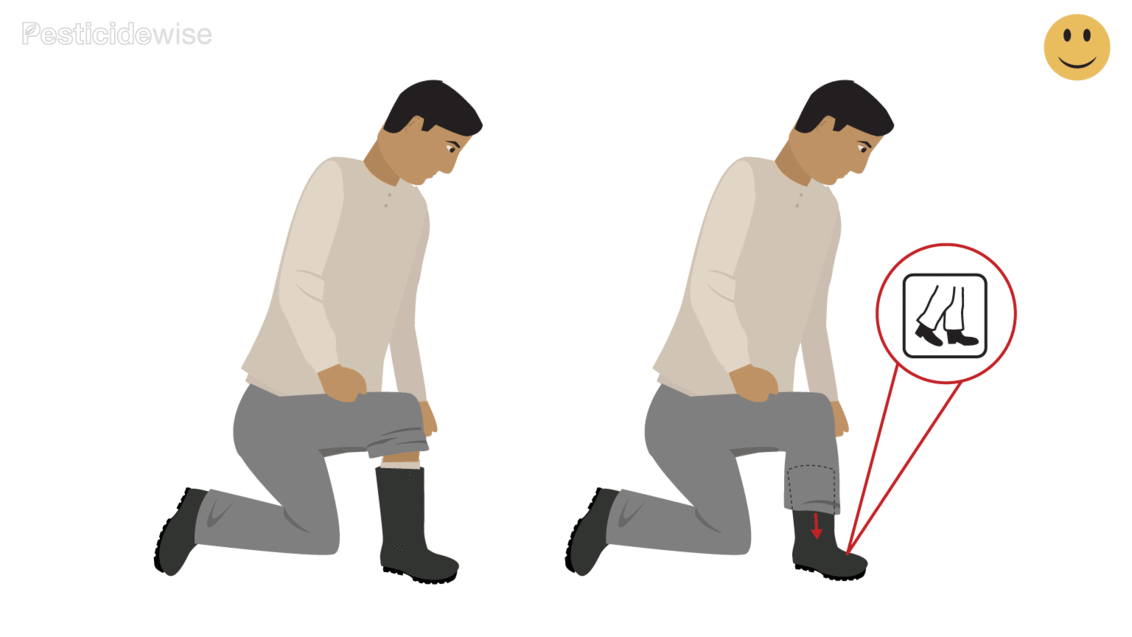
Check that your boots are clean inside and out and are in good condition. Wear the coverall/trouser legs on the outside of the boots so that spray cannot run down inside the boot.
Hints and tips for choosing rubber boots
- Choose unlined, chemical resistant boots made for use with pesticides.
- Check the tread of the boot will stop you slipping.
- Make sure the boots reach your knee and fit well.
Different types of boots can be seen on this UK site.
Must: You must clean your boots before you remove them.
Never: Never use boots which leak or are damp with pesticide on the inside.
Protect your body
add
remove
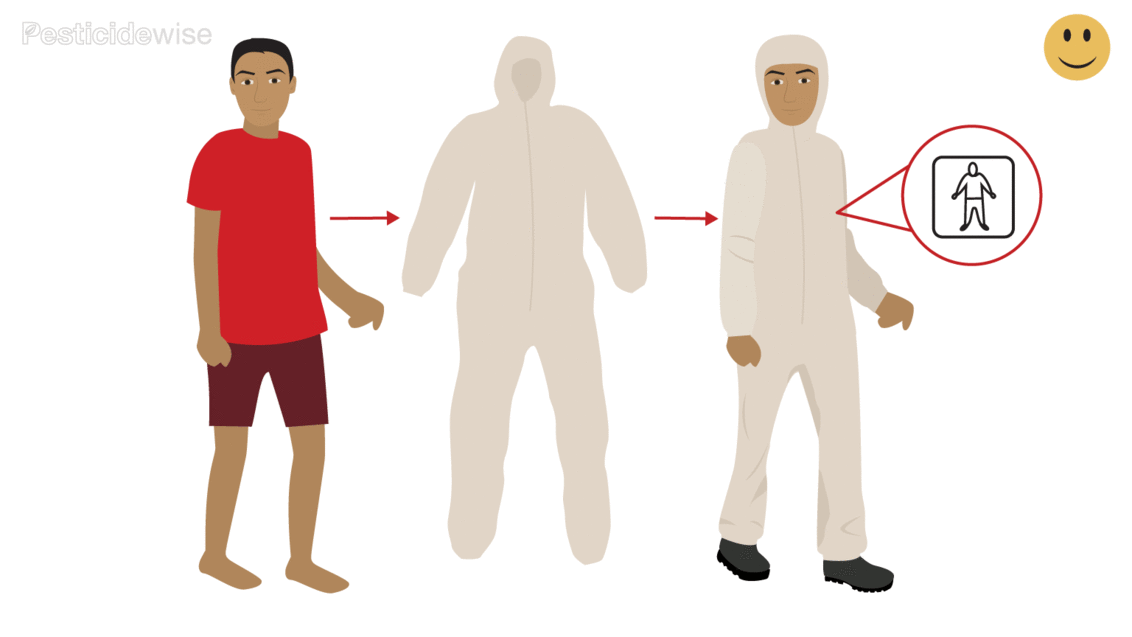
Wear the right PPE to protect:
- your skin from spills and splashes when mixing and using pesticide
- your back and arms from pesticide leaking from your knapsack sprayer.
Check your pesticide label for advice on what you should wear. Some pesticide labels will allow the user to use "every-day" clothes of long sleeved shirts and long trousers as PPE. Some countries insist that you use a coverall.
Whether you use "every day" clothes or a coverall, this PPE is:
- worn over your work clothes (of at least t shirt and shorts) so that you are wearing two layers.
- kept solely for use with pesticides.
How to wear your PPE of long sleeved shirt and long trousers or coverall
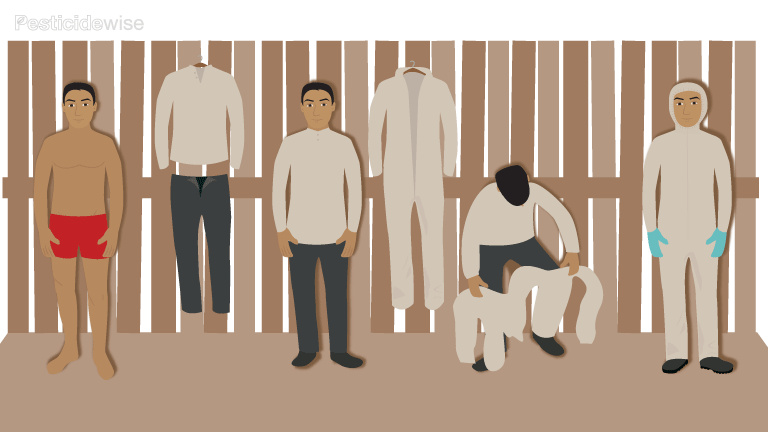
- Your PPE (of either long sleeved shirt and long trousers or coverall) is worn over your work clothes so that you are wearing two layers.
- Check what your label advises. You are likely to need to wear work clothes of trousers and a shirt under your PPE.
- Put on your work clothes and fasten your shirt to the neck.
- Put on your PPE over your work clothes. Fasten your PPE to the neck.
- Wear the trouser leg of your PPE over the outside of your boots so that the pesticide does not run down the inside of the boot.
- Wear gloves tucked inside of your shirt sleeve when spraying downwards or laterally. Wear shirt sleeves tucked inside of your gloves when spraying upwards and laterally.
- Tape the join of sleeve and glove if spraying upwards or laterally.
Hints and tips for choosing your coverall or your long sleeved shirt and long trousers: Coveralls
Many coveralls are made of cotton or cotton and polyester blend and are not chemical resistant. Others are coated to be water resistant and give some protection from some solvents. Check your pesticide label for advice. Coveralls can be in one or two pieces and cover the main part of the body. Those with a hood also protect the head and neck.
Choose a coverall with:
- a loose fit so that you can work with ease
- elastic at the wrists, ankles and hood to help keep pesticide from reaching your skin
- no external pockets which can trap pesticides.
Also check that the coverall:
- covers all your body and arms when stretching
- is light
- will not absorb pesticide
- will not rip easily
- can be washed if re-usable.
Different types of coverall can be seen on this UK site. Long sleeved shirt and trousers
- Choose a shirt and trousers that are in good condition and will not absorb the pesticide.
- Make sure that all zips and buttons work properly.
- Cut off all external shirt pockets.
Must:
- You must keep your PPE of long sleeved shirt and trousers or coverall just for use with pesticides.
- Remove your PPE straight away if it becomes damp with pesticide. Wash yourself, change into clean clothes and wash the contaminated clothes.
- Take care when removing the lower legs of your coveralls or trousers as they are likely to be contaminated.
- Wear at least one layer of clothes that cover your entire body.
Never: Never wear PPE that is dirty from an earlier use.
Protect your head and neck
add
remove
Wear hats or hoods to protect your head from falling drops of pesticide when spraying upwards and from contact with sprayed leaves.
How to wear your hat or hood
- Use clean gloves or hands to put on and take off your hat or hood.
- If you wear a hat, tie back long hair and cover. Make sure your hat is secure on your head.
- If you wear a coverall with hood, make sure that your hair is tucked inside the hood.
- If you wear goggles, make sure that the hat does not break the seal between the goggles and your skin.
Hints and tips for choosing a hat or hood:
Must: You must keep your hat solely for use with pesticides.
Never: Never wear baseball caps or any type of hat that will absorb pesticides. Never keep wearing a hat if it becomes damp with spray.